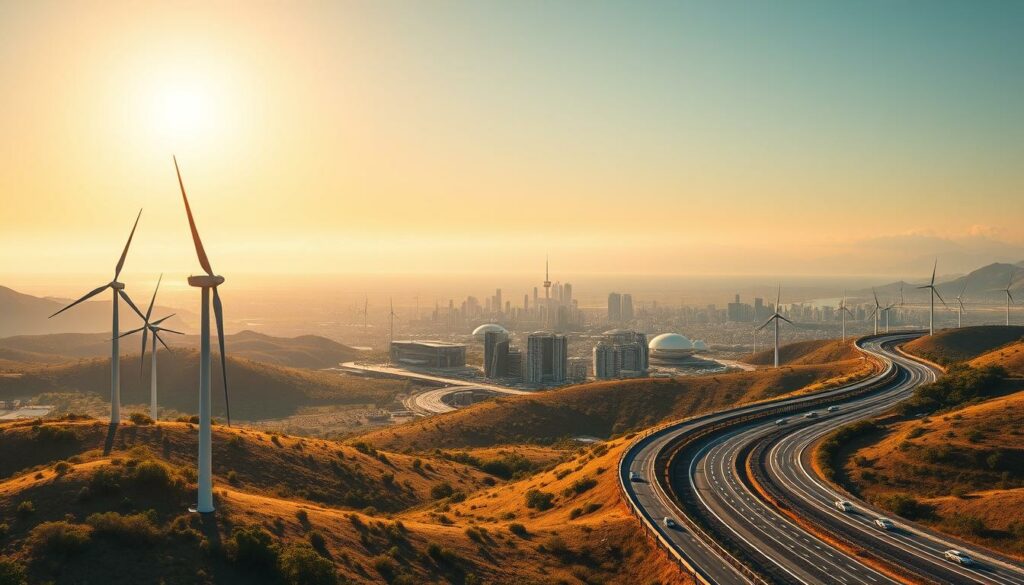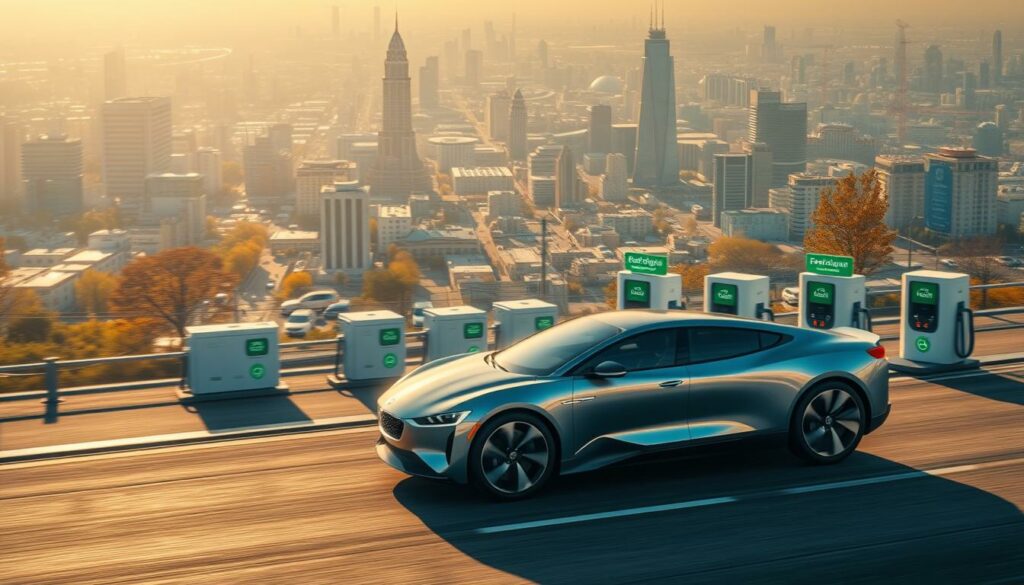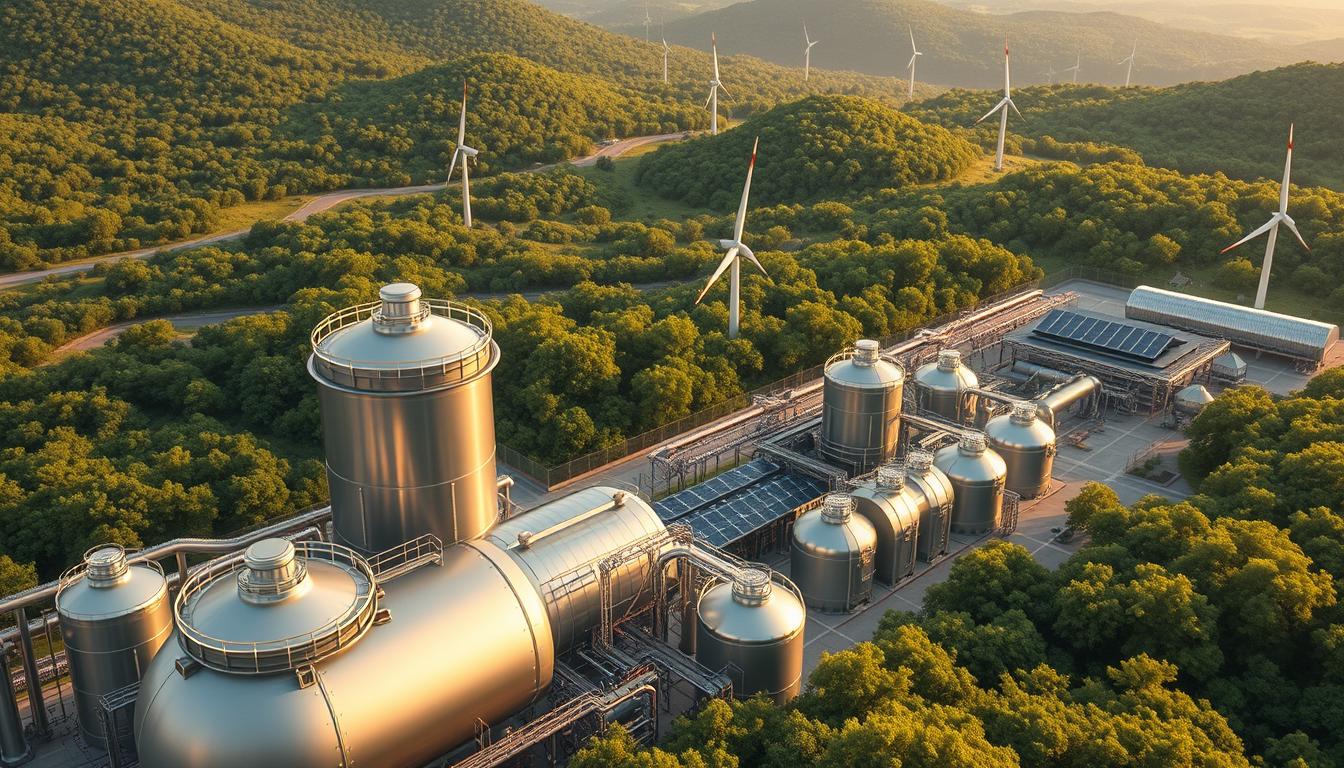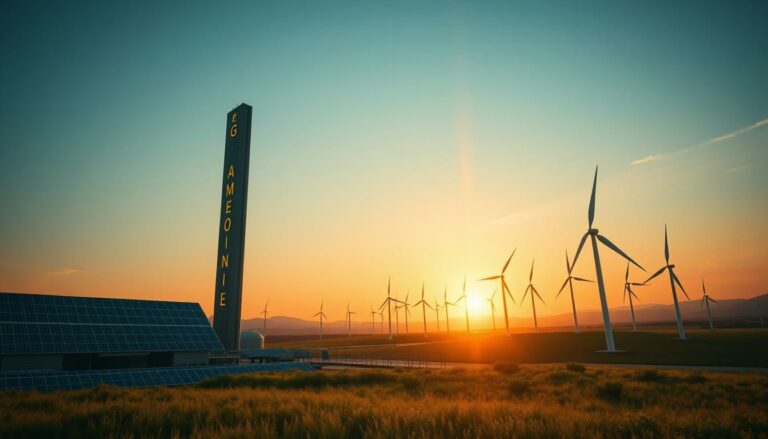Did you know hydrogen has about three times the energy of gasoline by weight? This shows how promising green hydrogen is for clean energy. The U.S. Department of Energy aims to make 10 million metric tons of “clean hydrogen” by 2030. By 2050, they want to make 50 million metric tons.
Green hydrogen is made by using renewable electricity to split water. This makes it a zero-emission fuel. Unlike traditional methods, green hydrogen is made without fossil fuels. It only leaves water vapor behind.
As more people look for renewable energy, green hydrogen is becoming important. It’s helping us move towards a greener future. Thanks to better technology and more investment, making green hydrogen is getting cheaper and more efficient. This is key for meeting the demand for zero-emission fuels in many areas.
Key Takeaways
- Green hydrogen is produced using renewable energy and water electrolysis
- It offers a zero-emission alternative to fossil fuels
- The U.S. DOE aims for 50 million metric tons of clean hydrogen production by 2050
- Green hydrogen contains three times more energy by weight than gasoline
- Advancements in technology are making green hydrogen production more efficient
- Global interest and investments in green hydrogen are rapidly increasing
Understanding Green Hydrogen Technology
Green hydrogen is a key player in clean energy. It uses renewable electricity to split water into hydrogen and oxygen. This zero-emission fuel is changing industries like aviation and trucking.
The Science Behind Water Electrolysis
Electrolysis is the heart of green hydrogen. It breaks water into hydrogen and oxygen using renewable electricity. Electrolyzers are getting better, with systems now 60% to 80% efficient.
The cost of these systems is dropping. By 2040, they might be half as expensive. This makes green hydrogen more affordable.
Renewable Energy Integration
Renewable energy is key for green hydrogen. Wind and solar power are main sources. Their costs have fallen a lot in the last decade.
Zero-Emission Production Process
Green hydrogen production has no emissions, only water vapor. This is a big difference from traditional methods, which emit a lot of CO2. Steel making alone is responsible for 6-7% of global CO2 emissions.
Even though green hydrogen is a small part of hydrogen production now, its future is bright. With the right support, it could grow to 700 million tonnes by 2050. This would be a big step towards cleaner energy.
The Global Shift Towards Clean Energy Solutions

The world is changing fast as countries aim to cut down carbon emissions. Green hydrogen is playing a big role in this change. It’s seen as a key solution to fight climate change. The market for green hydrogen is growing fast, expected to jump from $1.1 billion in 2023 to $30.6 billion by 2030.
This growth shows how urgent it is to tackle climate issues. Countries are setting big goals for using green hydrogen. For example, India wants to make 5 million metric tons of green hydrogen by 2030. Spain has also upped its goal to 11 GW of green hydrogen capacity by 2030, from 4 GW before.
Green hydrogen is being used to cut down emissions in hard-to-reduce areas. The steel industry, which causes about 9% of global CO2 emissions, could see big cuts by switching to green hydrogen. This might make steel more expensive, but it’s a step towards a cleaner world.
The energy transition is also happening in transport. Hydrogen cars could make up 25% of global sales by 2040. This change is part of a bigger move towards sustainable and eco-friendly options in many industries.
As we move towards a greener future, green hydrogen is becoming a key player. It helps cut emissions in many areas. This makes it a vital part of the global effort to reduce carbon and promote sustainable growth.
Green Hydrogen Production Methods
Green hydrogen is made using renewable power, which means it doesn’t emit carbon. The main way to make it is through electrolysis. This process uses special technology to split water into hydrogen and oxygen.
Electrolysis Systems and Equipment
There are two main types of electrolyzers: alkaline and proton exchange membrane (PEM). Alkaline systems use potassium hydroxide, while PEM uses a solid membrane. Both turn water into hydrogen gas and oxygen.
Infrastructure Requirements
To make green hydrogen cheaper, we need to build bigger plants. The International Renewable Energy Agency (IRENA) says bigger plants can cut costs by over a third. We need a lot of infrastructure, like renewable energy and water systems.
Storage and Distribution Networks
Good storage and distribution systems are key for green hydrogen to be widely used. Making hydrogen near where the sun shines can help big industries. Smaller plants can save on shipping costs. Storing extra energy helps keep hydrogen production steady.
| Production Method | Infrastructure Needs | Cost Reduction Potentia |
|---|---|---|
| Centralized | Large-scale electrolyzer plants, renewable power sources | 33% reduction with 20MW plant size |
| Distributed | Localized electrolyzers, storage facilities | Lower transportation costs |
Applications Across Industries

Green hydrogen is changing many sectors, helping with clean energy and reducing carbon emissions. It’s making a big impact in transportation, manufacturing, power generation, and chemical production.
Transportation and Mobility
Fuel cell vehicles are becoming more popular in cars. Hyundai aims to make 500,000 hydrogen cars by 2030. Also, 6,460 fuel cell buses were in use worldwide by 2021, with China leading.
The aviation industry is looking into hydrogen-powered planes to cut down on emissions.
Industrial Manufacturing
Green hydrogen is changing energy-hungry industries. In steelmaking, which is a big source of emissions, companies like H2 Green Steel are making green steel. The cement industry, which is also a big emitter, is using hydrogen to lessen its impact on the environment.
Power Generation Systems
Hydrogen is key in solving the problem of renewable energy being intermittent. It can be made from extra renewable energy and used in gas turbines. This makes power production reliable and cuts down on fossil fuel use.
Chemical Production
The chemical industry, like ammonia production, uses a lot of hydrogen. Green ammonia, made with renewable energy, can help make fertilizer production cleaner. The market for green hydrogen in petrochemicals is expected to grow to $17.5 billion by 2030.
| Industry | Current Emissions | Green Hydrogen Impact |
|---|---|---|
| Steel | 7% of global GHG | Potential for zero-emission steel production |
| Cement | 9% of global carbon emissions | Reduced emissions through hydrogen fuel mix |
| Ammonia | 43% of hydrogen consumption | $3.8 billion green hydrogen market by 2030 |
| Refining | 4% of global emissions | 25% emission reduction by 2050 |
Economic Viability and Market Growth
The green hydrogen market is growing fast. This is thanks to more investment and the chance to cut costs. In 2023, it was worth $3.8 billion. By 2032, it could hit $78.13 billion, showing investors believe in the hydrogen economy.
Now, making green hydrogen costs between $3 and $8 per kilogram. Grey hydrogen is cheaper, at $1 to $2. But, experts say green hydrogen costs could drop by 50% by 2030. By 2050, it might cost just $1 to $1.5 per kilogram in some places. This drop in cost is key for making green hydrogen more affordable and competitive.
| Region | Green Hydrogen Production (2023) |
|---|---|
| Asia Pacific | 93.6 kilotons |
| Europe | 31.6 kilotons |
| North America | 19.4 kilotons |
| Africa | 1.7 kilotons |
| South and Central America | 1.1 kilotons |
| Middle East | 0.1 kilotons |
Global efforts are boosting the hydrogen economy. Japan has promised $10 billion for clean energy and hydrogen projects. India aims to be a big hydrogen exporter with a $2 billion program. The US’s Inflation Reduction Act also offers big tax breaks for low-carbon hydrogen, encouraging more investment.
As we focus more on reducing carbon emissions, green hydrogen demand will rise. By 2050, it could make up 5% of the world’s energy use. This growth means big chances for economic growth and new jobs in the hydrogen industry.
Environmental Benefits and Sustainability
Green hydrogen is a key player in sustainable energy, bringing big environmental wins. It’s a clean fuel that helps cut down greenhouse gases and supports a circular economy. Let’s dive into how it benefits our planet and air.
Carbon Emission Reduction
The U.S. transportation sector is a big source of carbon dioxide emissions, making up about 33%. Green hydrogen offers a strong solution. Hydrogen-powered cars don’t release harmful pollutants, only water vapor and warm air. This clean burning can greatly reduce carbon emissions in many sectors.
Air Quality Improvements
Almost half of the U.S. population lives in areas with bad air. Green hydrogen can make the air much cleaner, mainly in cities. It burns cleaner than fossil fuels, cutting nitrogen oxides by over 90%. This big drop in harmful emissions means healthier air for everyone.
Renewable Resource Utilization
Green hydrogen is made using renewable energy like wind, solar, and hydroelectric power. This use of sustainable energy in making hydrogen supports a circular economy. It makes energy systems more efficient by using renewable resources when they’re plentiful.
| Aspect | Impact |
|---|---|
| Carbon Emissions | Zero during green hydrogen production |
| NOx Reduction | >90% compared to fossil fuels |
| Byproduct | Water vapor |
| Energy Source | 100% renewable |
Regional Development and Investment
Green hydrogen is becoming more popular worldwide as countries set up hydrogen strategies and energy policies. The World Bank Group is helping to develop projects and bring in investments in this new field.
European Union Initiatives
The European Union is at the forefront of the green hydrogen market. They aim to make 10 million tonnes of renewable hydrogen by 2030. The continent is seeing big investments in hydrogen hubs and large plants.
Asia-Pacific Projects
Asia-Pacific countries are making big moves in green hydrogen. China is putting a lot into hydrogen infrastructure. Japan is focusing on new technologies. Australia is looking to be a big exporter of hydrogen.
North American Progress
The United States is stepping up its green hydrogen plans. The U.S. Department of Energy gave $7 billion for seven Hydrogen Hubs in October 2023. By January 2025, five hubs got initial funding to start Phase 1.
- Pacific Northwest Hydrogen Hub (PNWH2): $27.5 million awarded, aiming to produce 300-400 metric tons of clean hydrogen
- Mid-Atlantic Hydrogen Hub (MACH2): $750 million anticipated total funding, proposing 20 projects across three states
- ARCHES: $30 million awarded, targeting 400-500 metric tons of hydrogen production per day
Working together is key for the global green hydrogen economy. Projects and sharing knowledge across borders are driving innovation and growth.
Technological Innovations and Breakthroughs
The green hydrogen sector is seeing fast tech advancements. Advanced electrolyzers lead these changes, improving efficiency and cutting costs. Over 20 years, the cost of electrolyzers has fallen by 90%, making green hydrogen cheaper to produce.
New thinner membranes in electrolyzers are a big leap. They make 150% more hydrogen and use 10% less energy than old models. Also, grooved electrode structures boost performance by up to 50%.
Storage tech for hydrogen is also getting better. High-pressure systems, liquid hydrogen, and new materials like metal hydrides are increasing storage options. These advancements are vital for green hydrogen to be used more widely across industries.
Improvements aren’t just in making and storing hydrogen. New ways to transport and distribute it, like pipelines and ammonia, are making the green hydrogen system better. These steps are fueling the green hydrogen market’s expected growth of over 600% in 25 years.
Modular electrolyzer units are becoming more popular. They allow for easy scaling of hydrogen production. This flexibility is essential to meet the expected need for 130 to 345 gigawatts of electrolyzer capacity by 2030.
Challenges and Future Developments
The green hydrogen industry is facing big challenges to become a main energy source. It needs to lower costs, build more infrastructure, and get policy support. These are key steps for growing production.
Cost Reduction Strategies
Lowering production costs is key for green hydrogen to compete. The focus is on making electrolysis more efficient and improving fuel cell tech. The goal is to cut costs by 80% to $1 per kg in a decade, as part of the Hydrogen Shot initiative.
Infrastructure Development
Building more infrastructure is essential for green hydrogen’s growth. This includes setting up big production sites, strong distribution networks, and hydrogen refueling stations. Right now, only 1% of hydrogen is made through electrolysis, showing the need for big growth.
| Infrastructure Component | Current Status | Future Need |
|---|---|---|
| Production Facilities | Limited | Large-scale facilities |
| Distribution Network | Underdeveloped | Expanded pipeline network |
| Refueling Stations | Scarce | Widespread availability |
Policy Support Requirements
A solid regulatory framework is critical for green hydrogen’s adoption. Governments need to set long-term goals, offer financial help, and work together globally. These steps will help overcome hurdles and speed up the shift to a hydrogen economy.
Overcoming these challenges needs a united effort from all sides. By pushing for tech improvements, building more infrastructure, and supporting policies, green hydrogen can reach its full clean energy promise.
Conclusion
Green hydrogen is leading the way in the energy shift, helping us fight climate change. The global market hit over $6.49 billion in 2024. It’s expected to grow more than 31% by 2032. This shows green hydrogen is a key part of our future.
Green hydrogen has many uses. It can make steel production much cleaner by using hydrogen instead of coal. It also makes cars run cleaner, cutting NOx emissions by over 90% compared to gas.
World leaders are taking notice. The European Union wants to make 10 million tonnes of renewable hydrogen by 2030. The U.S. has a plan too, thanks to the Inflation Reduction Act. Big companies like Siemens Energy and Air Liquide are also investing in hydrogen.
But, there are obstacles. Making green hydrogen is expensive, and we don’t have enough places to store it yet. We need more innovation, money, and support from governments to move forward. Using green hydrogen in areas that pollute the most will help us reach a cleaner world faster.


